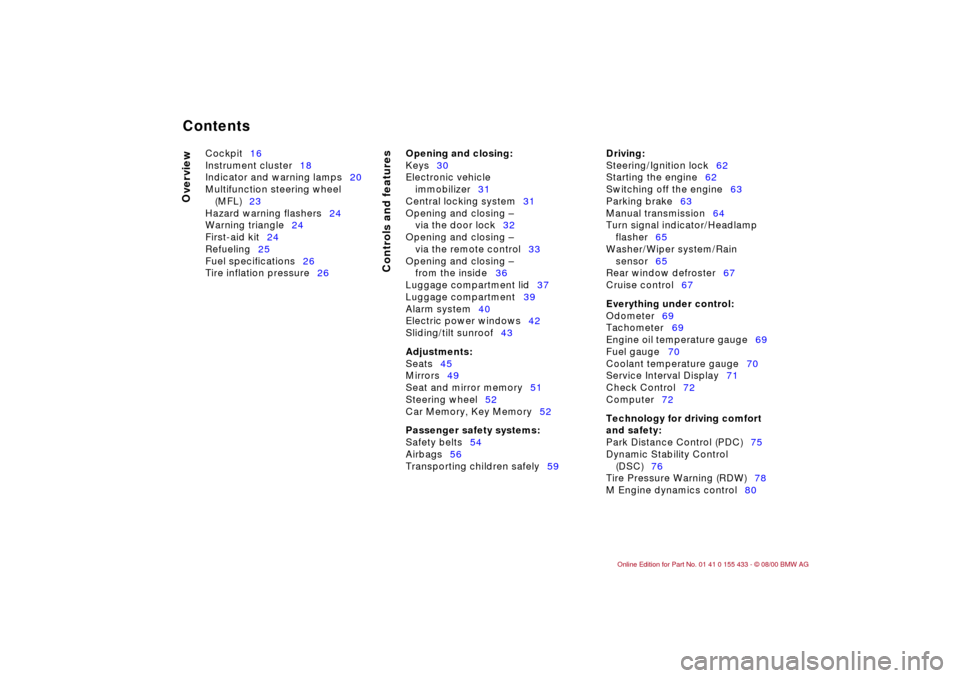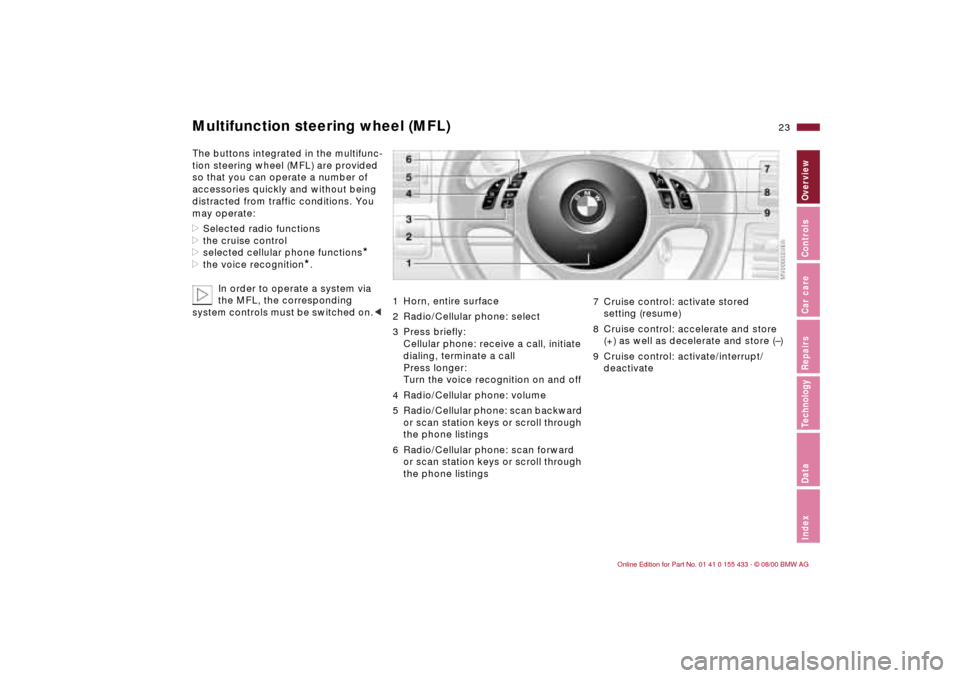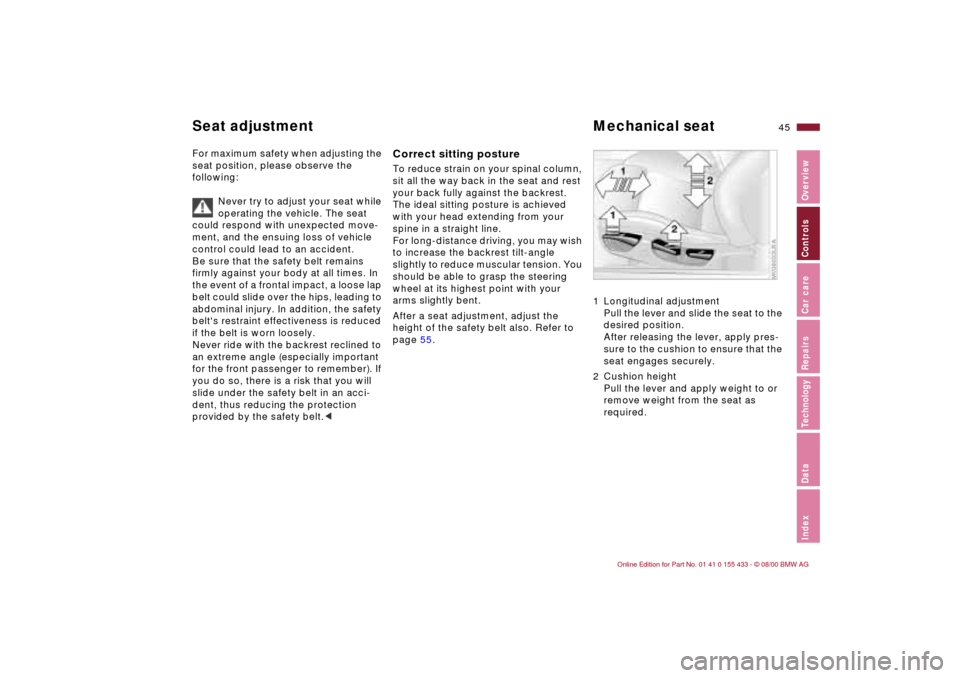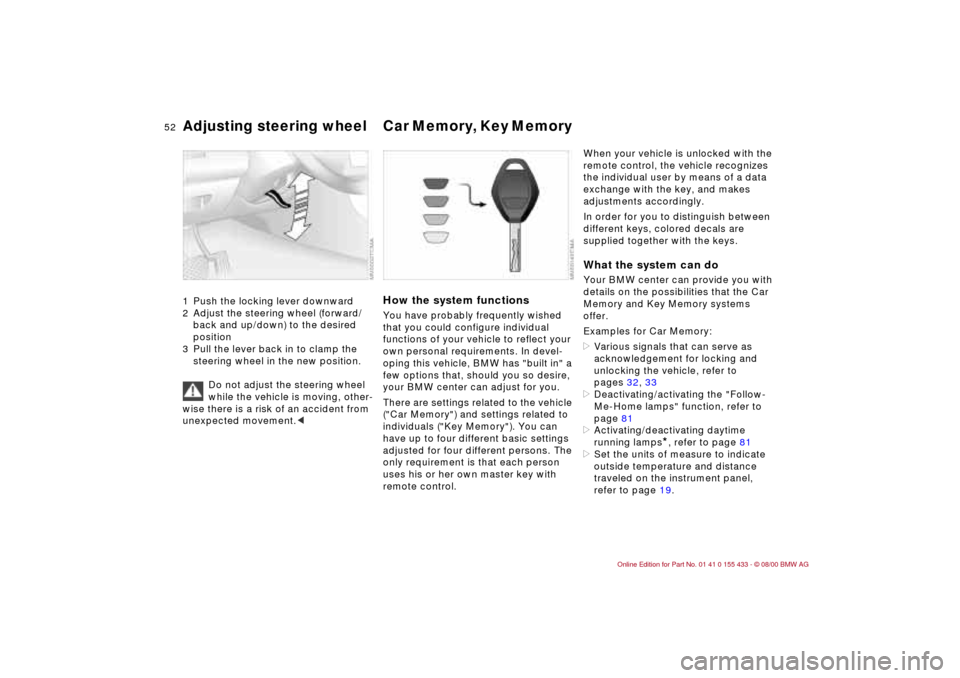steering wheel BMW M3 COUPE 2001 E46 Owner's Manual
[x] Cancel search | Manufacturer: BMW, Model Year: 2001, Model line: M3 COUPE, Model: BMW M3 COUPE 2001 E46Pages: 183, PDF Size: 1.65 MB
Page 10 of 183

Contents
Overview
Controls and features
Cockpit16
Instrument cluster18
Indicator and warning lamps20
Multifunction steering wheel
(MFL)23
Hazard warning flashers24
Warning triangle24
First-aid kit24
Refueling25
Fuel specifications26
Tire inflation pressure26
Opening and closing:
Keys30
Electronic vehicle
immobilizer31
Central locking system31
Opening and closing Ð
via the door lock32
Opening and closing Ð
via the remote control33
Opening and closing Ð
from the inside36
Luggage compartment lid37
Luggage compartment39
Alarm system40
Electric power windows42
Sliding/tilt sunroof43
Adjustments:
Seats45
Mirrors49
Seat and mirror memory51
Steering wheel52
Car Memory, Key Memory52
Passenger safety systems:
Safety belts54
Airbags56
Transporting children safely59
Driving:
Steering/Ignition lock62
Starting the engine62
Switching off the engine63
Parking brake63
Manual transmission64
Turn signal indicator/Headlamp
flasher65
Washer/Wiper system/Rain
sensor65
Rear window defroster67
Cruise control67
Everything under control:
Odometer69
Tachometer69
Engine oil temperature gauge69
Fuel gauge70
Coolant temperature gauge70
Service Interval Display71
Check Control72
Computer72
Technology for driving comfort
and safety:
Park Distance Control (PDC)75
Dynamic Stability Control
(DSC)76
Tire Pressure Warning (RDW)78
M Engine dynamics control80
Contents
Page 11 of 183

11n
Controls and features
Operation, care and maintenance
Lamps:
Side lamps/Low beams81
Instrument lightning81
High beams/Parking lamps82
Fog lamps82
Interior lamps82
Reading lamps83
Controlling the climate
for pleasant driving:
Automatic climate control84
Heated seats89
Roller sun blind89
Interior conveniences:
HiFi system90
Glove compartment90
Storage compartments91
Cellular phone92
Ashtray, front92
Cigarette lighter93
Ashtray, rear93
Clothes hooks94
Loading and transporting:
Through-loading system95
Ski bag96
Cargo loading97
Roof-mounted luggage rack98
Special operating instructions:
Break-in procedures102
Driving notes103
Catalytic converter103
Antilock Brake System
(ABS)104
Disk brakes106
Brake system107
Winter operation108
Power steering110
Cellular phones110
Radio reception110
Wheels and tires:
Tire inflation pressure111
Tire condition111
Tire replacement112
Tire rotation113
Wheel and tire
combinations114
Winter tires115
Snow chains115
Approved wheel and tire
specifications116
Under the hood:
Hood118
Engine compartment120
Washer fluids122
Washer nozzles122
Engine oil123
Coolant125
Brake fluid126
Vehicle Identification
Number126
Care and maintenance:
The BMW Maintenance
System127
Caring for your vehicle128
Airbags133
Vehicle storage133
Laws and regulations:
Technical modifications134
California Proposition
65 Warning134
OBD connector135
Page 15 of 183

Overview
Controls and features
Operation, care
and maintenance
Owner service procedures
Technical data
Index Advanced technology
15n
IndexDataTechnologyRepairsCar careControlsOverview
Cockpit16
Instrument cluster18
Indicator and warning lamps20
Multifunction steering wheel
(MFL)23
Hazard warning flashers24
Warning triangle24
First-aid kit24
Refueling25
Fuel specifications26
Tire inflation pressure26
Overview
Page 17 of 183

17n
IndexDataTechnologyRepairsCar careControlsOverview
Cockpit
1 Side lamps/Low beams81
2
d
Turn signal indicator65
>
Parking lamp82
>
High beams82
>
Headlamp flasher65
>
Computer72
3 Washer/Wiper system65
4 Hazard warning flashers24
5 Shift lever64
6 Rear window defroster67
7 Central locking system31
8 Adjusting steering wheel52
9 Horn, entire surface
10 Fog lamps82
Page 22 of 183

22n
Indicator and warning lamps
Tire Pressure Warning (RDW) l
RDW has been switched off or
has been deactivated because
of a malfunction. In the event of a
malfunction, have the system checked
by your BMW center.
For additional information, refer to
pages 26, 78.
Dynamic Stability Control
(DSC) l
The indicator lamp flashes when
the system is active and governs drive
force and braking force.
If the indicator lamp fails to go out after
the engine is started, or if it comes on
during normal driving and stays on:
DSC has been switched off via the
button or because of a malfunction.
In the event of a malfunction, have the
system checked by the nearest BMW
center.
For additional information, refer to
page 76 and on.
Add washer fluid
The washer fluid is too low.
Top up the fluid at the earliest
opportunity.
For additional information, refer to
page 122.
Service Engine Soon l
If the indicator lamp comes on
either continuously or intermit-
tently, this indicates a fault in the emis-
sions-related electronic systems.
Although the vehicle remains opera-
tional, you should have the systems
checked by your BMW center at the
earliest possible opportunity.
For additional information, refer to
page 135.
Warning lamp: Service Engine
Soon for Canadian models.
Engine electronics l
There is a fault in the engine's
electronic control system. The
electronics allow for continued driving
with reduced engine output or speed.
Please have the system inspected by
your BMW center.
Add coolant
The coolant level is too low.
Add coolant at the earliest
opportunity.
For additional information, refer to
page 125.
Green: for your information
Turn signal indicator
Flashes when the turn signal is
on. Rapid flashing: indicates a
system malfunction.
For additional information, refer to
page 65.
Cruise control
Lights up when the cruise
control is activated. Available for
operation via the multifunction steering
wheel (MFL).
For additional information, refer to
page 67.
Fog lamps
Lights up whenever fog lamps
are on.
For additional information, refer to
page 82.
Blue: for your information
High beams
Lights up when the high beams
are on or the headlamp flasher
is actuated.
For additional information, refer to
pages 65, 82.
Page 23 of 183

23n
IndexDataTechnologyRepairsCar careControlsOverview
Multifunction steering wheel (MFL)
The buttons integrated in the multifunc-
tion steering wheel (MFL) are provided
so that you can operate a number of
accessories quickly and without being
distracted from traffic conditions. You
may operate:
>Selected radio functions
>the cruise control
>selected cellular phone functions
*
>the voice recognition
*.
In order to operate a system via
the MFL, the corresponding
system controls must be switched on.<
1 Horn, entire surface
2 Radio/Cellular phone: select
3 Press briefly:
Cellular phone: receive a call, initiate
dialing, terminate a call
Press longer:
Turn the voice recognition on and off
4 Radio/Cellular phone: volume
5 Radio/Cellular phone: scan backward
or scan station keys or scroll through
the phone listings
6 Radio/Cellular phone: scan forward
or scan station keys or scroll through
the phone listings
7 Cruise control: activate stored
setting (resume)
8 Cruise control: accelerate and store
(+) as well as decelerate and store (Ð)
9 Cruise control: activate/interrupt/
deactivate
Page 28 of 183

28n
Locks and security systems:
Keys30
Electronic vehicle
immobilizer31
Central locking system31
Opening and closing Ð
via the door lock32
Opening and closing Ð
via the remote control33
Opening and closing Ð
from the inside36
Lugagge compartment lid37
Luggage compartment39
Alarm system40
Electric power windows42
Sliding/tilt sunroof43
Adjustments:
Seats45
Mirrors49
Seat and mirror memory51
Steering wheel52
Car Memory, Key Memory52
Passenger safety systems:
Safety belts54
Airbags56
Transporting children safely59
Controls
Page 45 of 183

45n
IndexDataTechnologyRepairsCar careControlsOverview
For maximum safety when adjusting the
seat position, please observe the
following:
Never try to adjust your seat while
operating the vehicle. The seat
could respond with unexpected move-
ment, and the ensuing loss of vehicle
control could lead to an accident.
Be sure that the safety belt remains
firmly against your body at all times. In
the event of a frontal impact, a loose lap
belt could slide over the hips, leading to
abdominal injury. In addition, the safety
belt's restraint effectiveness is reduced
if the belt is worn loosely.
Never ride with the backrest reclined to
an extreme angle (especially important
for the front passenger to remember). If
you do so, there is a risk that you will
slide under the safety belt in an acci-
dent, thus reducing the protection
provided by the safety belt.<
Correct sitting posture To reduce strain on your spinal column,
sit all the way back in the seat and rest
your back fully against the backrest.
The ideal sitting posture is achieved
with your head extending from your
spine in a straight line.
For long-distance driving, you may wish
to increase the backrest tilt-angle
slightly to reduce muscular tension. You
should be able to grasp the steering
wheel at its highest point with your
arms slightly bent.
After a seat adjustment, adjust the
height of the safety belt also. Refer to
page 55. 1 Longitudinal adjustment
Pull the lever and slide the seat to the
desired position.
After releasing the lever, apply pres-
sure to the cushion to ensure that the
seat engages securely.
2 Cushion height
Pull the lever and apply weight to or
remove weight from the seat as
required.
Seat adjustment Mechanical seat
Page 52 of 183

52n
Adjusting steering wheel Car Memory, Key Memory 1 Push the locking lever downward
2 Adjust the steering wheel (forward/
back and up/down) to the desired
position
3 Pull the lever back in to clamp the
steering wheel in the new position.
Do not adjust the steering wheel
while the vehicle is moving, other-
wise there is a risk of an accident from
unexpected movement.<
How the system functionsYou have probably frequently wished
that you could configure individual
functions of your vehicle to reflect your
own personal requirements. In devel-
oping this vehicle, BMW has "built in" a
few options that, should you so desire,
your BMW center can adjust for you.
There are settings related to the vehicle
("Car Memory") and settings related to
individuals ("Key Memory"). You can
have up to four different basic settings
adjusted for four different persons. The
only requirement is that each person
uses his or her own master key with
remote control.
When your vehicle is unlocked with the
remote control, the vehicle recognizes
the individual user by means of a data
exchange with the key, and makes
adjustments accordingly.
In order for you to distinguish between
different keys, colored decals are
supplied together with the keys.What the system can doYour BMW center can provide you with
details on the possibilities that the Car
Memory and Key Memory systems
offer.
Examples for Car Memory:
>Various signals that can serve as
acknowledgement for locking and
unlocking the vehicle, refer to
pages 32, 33
>Deactivating/activating the "Follow-
Me-Home lamps" function, refer to
page 81
>Activating/deactivating daytime
running lamps
*, refer to page 81
>Set the units of measure to indicate
outside temperature and distance
traveled on the instrument panel,
refer to page 19.
Page 57 of 183

57n
IndexDataTechnologyRepairsCar careControlsOverview
AirbagsSitting correctly with airbags
Comply with the following instruc-
tions for the airbags. If you do not,
the airbags may not be able to provide
their maximum protection, with
resulting risks to personal safety. The
following information pertains to all
occupants:
Even though there is an airbag, wear a
safety belt every time you get in the
vehicle, because airbags supplement
the safety belts as an additional
restraint device.
Assume a sitting posture that is
comfortable and allows the greatest
possible distance between you and the
airbags.
Always hold the steering wheel by the
rim to keep any chance of injury to
hands or arms to an absolute minimum,
should the airbag deploy. Keep the
instructions regarding sitting properly in
your seat on page 45 in mind as well.
No one and nothing is to come between
the airbag and the seat occupant.
Do not use the cover panel above the
front passenger-side airbag as a
storage area.
Do not apply adhesive materials to the
cover panels of the airbags, cover them
or modify them in any other way.
Do not use any child restraint systems
on the passenger side. Children under
12 years of age, who are smaller than
5 feet (150 cm), may ride in the back
only.
If your vehicle is equipped with side
airbags in the rear passenger area, be
sure that child restraints are mounted
correctly and provided with the
greatest-possible distance between the
airbags in the side trim panels. Do not
allow children to lean out of the child's
seat in the direction of the side trim
panels. If they do so, serious injuries
can occur if the airbag is triggered.
(infants and small children in appro-
priate child restraint systems; larger
children and adults using the safety
belts). Never let an occupant's head
rest near or on a side airbag because
the inflating airbag could cause a
serious or fatal injury. Please note that
the word "Airbag" imprinted on the door
trim panel indicates the airbag's loca-
tion.
Accident research shows that the
safest place for children in an automo-
bile is in the rear seat. However, a child
sitting in the rear seat and not properly
restrained may place his or her head on
or near the airbag, if so equipped. For
example, a child Ñ even though belted
Ñ may fall asleep with his or her head
against the side airbag. It may be diffi-
cult for a driver to ensure that children
in the rear seat will remain properly
positioned at all times and not place
their heads on or near the side airbag.
Therefore, we recommend that the rear
seat side airbags, if so equipped, be
deactivated if children will travel in the
rear seat.
The rear seat side airbags may already
have been deactivated, either at the
time of manufacture or by a BMW